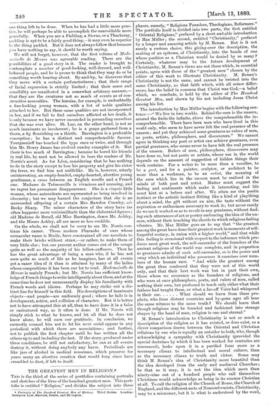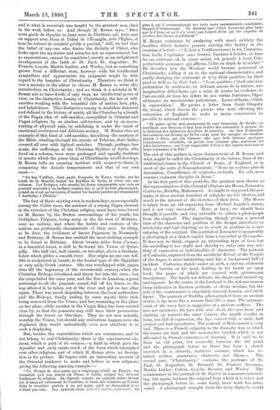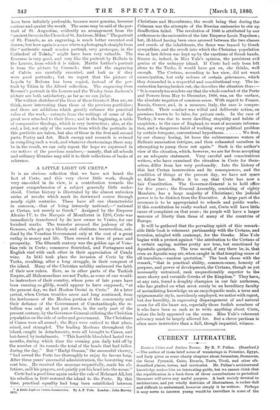THE GREATEST MEN IN RELIGION.* Tins is the third of
the series of portfolios containing portraits and sketches of the lives of the hundred greatest men. This port- folio is entitled. " Religion," and divides the subject into three
• Portraits of The Hundred Greatest Men of History. Third Series. London: Sampson Low, Marston, Searle, and Rivington.
phases, namely, "Religious Founders, Theologians, Reformers." The portfolio itself is divided into two parts, the first entitled Oriental Religions," prefaced by a short and able introduction by Max Muller ; the second, entitled " Christianity," prefaced by a longer and amusing article by M. Renan. But is it not surely a curious choice, this giving-over the description, the making of an epitome, of Christianity, into the hands of one whose position as a Christian would be denied by so many ? Certainly, whatever may be the future development of Christianity, M. Renan's views are not those which, in essential points, agree with those of the " greatest men " chosen by the editor of this work to illustrate Christianity. M. Renan's Christianity is not the same, and cannot be twisted into the same Christianity, as that faith which, with all minor differ- ences, has the belief in common that Christ was God,—a belief which, we conclude, is held by the editor of The Hundred Greatest Men, and shown by his not including Jesus Christ among his list.
The introduction by Max Muller begins with the following sen- tence :—" We live in two worlds. Behind the seen is the unseen, around the finite the infinite, above the comprehensible the in- comprehensible. There have been men who have lived in this world only, who seem to have never felt the real presence of the unseen ; and yet they achieved some greatness as rulers of men, as poets, artists, philosophers, and discoverers." We cannot agree in thinking any poet or artist can achieve greatness, even partial greatness, who seems never to have felt the real presence of the unseen. Rulers of men, philosophers, discoverers may have done so, but not poets or artists, whose use in the world depends on the amount of suggestion of hidden things their work contains. For a writer to be more than a versifier, to be a poet, and for a painter, sculptor, or architect to be more than a workman, to be an artist, the meaning of the seen which lies in the unseen must be realised in the minds of both poet and artist. Matter must suggest the feeling and sentiments which make it interesting, and life must hint at a before and after. We often see the poetic instinct or the artistic instinct flitting like a kind of plaything about a mind, the gift without an aim, the taste without the aspiration or enthusiasm necessary to work it; but never surely do we see it worked so as to result in any greatness, without find- ing such utterances of art or poetry embracing the idea of the un- seen, without their touching the chords to which religious feeling vibrates. Mr. Max Muller goes on to say that "the greatest among the great have done their greatest work in moments of self- forgetful ecstacy, in union with a higher world," and that while this feeling is occasional with respect to the influence which pro- duces most great work, the self-surrender of the founders of the ancient religions of the world was complete, and in proportion as greatness admits of such self-surrender, so is the power and sway which an individual who possesses it exercises over num- bers of the human race. " And while the greatest among the great thus confessed that they were not of this world only, and that their best work was but in part their own, those whom we reverence as the founders of religions, and who were at once philosophers, poets, and rulers of men, called nothing their own, but professed to teach only either what their fathers had taught them, or what a far-off Voice had whispered
in their ear What should we learn from these pro- phets, who from distant countries and by-gone ages all bear the same witness to the same truth ? We should learn that though religions may be founded and fashioned into strange shapes by the hand of man, religion is one and eternal."
M. Renan's introduction to Christianity is not so much a description of the religion as it has existed, or does exist, as a clever comparison drawn between the Oriental and Christian religions by one who is equally an outsider to both, who, though acknowledging a sympathy with Christianity (provided the special doctrines by which it has been worked for centuries are renounced), looks upon it in a purified form more as a necessary climax to intellectual and moral culture, than as the necessary climax to truth and virtue. Some may think M, Renan's idea of Christianity. more beautiful than the idea developed from the early and mediaaval Churches ; be that as it may, it is not the idea which more than ninety-nine out of a hundred people who call themselves Christians would acknowledge as being in its essence Christian at all. To call the religion of the Church of Rome, the Church of England, and the different sects of Nonconformists, Christianity, may be a misnomer, but it is what is understood by the word,
and is what in essentials was taught by the greatest men cited in the work before us. And though M. Renan says, " Dieu
nous garde de repudier ce beau nom de Chretien, qui nous met en rapport avec Jesus et l'ideal de l'Evangile, avec I'Eglise, et tons les tresors de saintete qu'elle a produit," still, we feel that the belief of any one who denies the divinity of Christ, who looks upon the mysteries and miracles not as supernatural, but as superstitions, cannot be considered merely as an enlightened development of the faith of St. Paul, St. Augustine, St. Francis, Loyola, Martin Luther, and Wesley, but as something grown from a different stem, however wide his intellectual sympathies and appreciative his judgment might be with regard to the beauties of Christianity. Therefore we think it was a mistake in the editor to choose M. Renan to write this introduction on Christianity ; and we think it a mistake in M. Renan not to have dwelt, if only from an intellectual point of view, on the distinctive beauty of Christianity, the law of self- sacrifice working with the beautiful side of nature, love, pity, and helpfulness. This distinctive beauty is doubtless distorted and defaced in the history of nearly all the Churches by a breath of the Pagan idea of self-sacrifice, exemplified in Oriental and Pagan religions by an aimless self-torture, and by an accen- tuating of physical pain, by exhibiting it under the mask of emotional excitement and delirious ecstacy. M. Renan cites an example of this kind of self-sacrifice, describing the martyrs of the Babis winding through the streets of Teheran, their bodies covered all over with lighted matches. Though, perhaps, less acute, the sufferings of the Christian Stylites of Syria, who lived on a column, were more prolonged and equally destitute of results which the purer ideas of Christianity would develope.
M. Renan tells an amusing incident with respect to these, in comparing the Asiatic temperament and that of our own races :—
" Ce bon Vulfilalc, dont parle Gregorie de Tours, voulat, stir les bords de la Moselle, imiter les Stylites de Syrie, et vivre sur une colonne. Les Eveques, tres senses, lui firent comprendre quo cela ne pouvait convenir a an barbare comme lui, et qu'il tie faut pas essayer, -quad on n'est mean rustre, d'imiter les hautes parties qui reussissent
Antioche, a Chalcis."
The fact of there existing even in modern days, more especially among the Celtic races, the mixture of a strong Pagan element in the exercises of the Christian religion, must have been forced on M. Renan by the Breton surroundings of his youth, his birthplace, Treguier, being away in the far west of Brittany, near no railway, and where the habits and customs of the natives are profoundly characteristic of their race. In citing, as he does, the evidences of latent Paganism in Normandy and Brittany, M. Renan has omitted the most striking example to be found in Brittany. About twenty miles from Carnac, in a beautiful forest, is still to be found the Venus of Quini- pilly. She half sits, half stands, on her altar, above a fountain, below which glides a smooth river. Her origin no one can tell.
She is sculptured in basalt, in the formal type of the Egyptian or very early Greek statues. She was worshipped with pagan rites till the beginning of the seventeenth century, when the Christian Bishops interfered and threw her into the river ; but the crops failed the Fame year, and the Duc de Lannion, a great personage to all the peasants round, fell off his horse, so she was allowed to be taken out of the river and put on her altar again. There was much disputing between the local authorities and the Bishops, finally ending by some mystic little stole being removed from the Venus, and her remaining in her place on her altar; while another to the Virgin Mary has been erected close by, so that the peasants may still have their processions through the forest on fete-days. They do not now actually worship the Venus, but should any misfortune happen were she displaced, they would undoubtedly even now attribute it to such a displacing.
But, besides the superstitions which are extraneous, and do
not belong to real Christianity, there is the supernatural ele- ment, which is part of its essence,—a faith in which gave the Apostles and early saints much of the force which triumphed over other religions, and of which M. Renan gives no descrip- tion in his preface. He begins with an interesting account of the Oriental tendency to make and believe in new religions, giving the following amusing example :—
" En Persan de mes ands, qui a longtemps reside en France, me racontait qu'i son retoar en Perse, ii faillit, malgre lui, devenir fondatear de religion. Sa legende conrait en quelque sorte devant lui, it essayait vainement de l'arreter; le bruit des miracles qu'il avait faith le troublait parfois a 1111 tol point, gull se demandait si ce n'etait pas vrai. Son symbole etait, Liberte, egalitJ, fraternite ; lea gene a qui ii communiquait ces trois moth sacramentels tombaient, frappes d'etonnement. Bs disaient quo c'etait boaaeoup plus beau que le Coran, et qu'il n'y avait que l'esprit divin qui fat capable de reveler des choses si sublimes."
M. Renan continues by analysing with much subtlety the faculties which Asiatics possess causing this facility in the creation of beliefs :—" L'Asie a l'enthousiasrne, la foi, l'imagina- tion facile, l'esperance sans bornes, l'audace a feindre, et dans les ens extremes oil la cause sainte eat poussee ii bout, l'im- perturbable assurance qui affirme, rid& en depit de la realite." He describes how the Western world became possessed of Christianity, adding it on to the national characteristics, and partly changing the sentiment of it by their qualities, by their good as well as by their bad :—" Leur qnalites, c'etait uue rare profondeur de sentiment, un delirant amour de la nature, uue imagination debordante, qui a teint de toutes lea couleurs de l'arc-en-ciel, de tons les reflets de nos vertes fontaines, l'Apre secheresse du messianisme palestinien. Lours (Wants, c'etait la superstition." He quotes a letter from Saint Gregory the Great, which directs the priests who were effecting the conversion of England to make as many concessions as possible to national customs :—
" Et parse gulls sont accoutume de tuer boancoup de bceufs, en sacrifiant aux demons, it faut leur etablir dos solonnites it propos do la dedicate des eglises on des fetes de martyrs. Au lieu d'immoler des animaux an demon, qu'ils les tuent pour les manger en rondant graces a Dieu, qui lea rassasie, afire que, lour laissant quelques rejouissances sensibles, on puisso bear insinuer plus aisement lea joies interieures ; car it est impossible d'fiter it des esprits durs toutes bears contumes a la foie."
The end of this preface is more characteristic of M. Renan and what might be called the Christianity of the future, than of the established forms in the Church of Rome, of England, or in most of the sects of Nonconformists : "Nous ne voulons plus de damnation, d'anathemes, de symboles exclusifs. En cola nous sommes vraiment disciples de Jesus."
In the first part of this portfolio, the greatest men chosen as the representatives of the Oriental religions are Moses, Zoroaster, Confucius, Buddha, Mahom med. As might be supposed, the por- traits of these ancient founders of religions are too ideal to add much to the interest of the sketches of their lives. The Moses is taken from an old engraving from Michael Augelo's statue, and is not very successful. Here, at least, we should have thought it possible and very advisable to obtain a photograph from the original. This engraving, though giving a general view of the character and position of the design, introduces so much false and bad drawing, as to result in portions in a cari- caturing of the original. The portrait of Zoroaster is apparently a photograph of a sketch copied from a bas-relief at Persepolis- It does not, we think, suggest an interesting type of face, but the modelling is too slight and sketchy to enter into any sub- tlety of expression or individuality of character. The portrait of Confucius, engraved from the sacrificial Ritual of the Temple of the Sages, is more interesting, and has a background full of incident. Confucius stands under an arch, a curious, elaborate kind of beretta on his head, holding in his hands an open book, the pages of which are covered with picturesque inscriptions. The hands are delicate, the finger-ends turned up and tapered. In the centre of the forehead is the not uncommon lump indicative in Eastern portraits of divine wisdom, but the rest of the countenance is singularly natural, human, and intel- ligent. The portrait of Buddha, photographed from an ancient statue, is far more like a woman than like a man. The arrange- ment of the wavy hair is suggestive of a modern coiffeur. The ears are enormous, the face wide and short, the eyes large and slanting up towards the outer corners, the mouth regular in form, but full of expression, the lips curved with a smile, half cynical and half speculative. The portrait of Mahommed is very bad. There is a French vulgarity in the dramatic way in which the brows are knit and the moustaches twirled, which is not alleviated by French correctness of drawing. It is said to be from an old print, but assuredly between the old print and the photograph before us there has been a sketch executed in a slovenly, inartistic manner, which has re- tained neither quaintness, character, nor likeness. The second part, " Christianity," contains the portraits of St.
Paul, St. Augustine, St. Bernard, St. Francis, Erasmus, Martin Luther, Calvin, Loyola, Bossuet, and Wesley. The countenance in the portrait of St. Paul is in a measure interest- ing, but again, between the original from which it is taken and the photograph before us, some hasty, loose work has inter- vened. A photograph straight from the ivory diptyche would have been infinitely preferable, because more genuine, however curious and quaint the result. The same may be said of the por- trait of St. Augustine, evidently an arrangement from the " ancient fresco in the Church of St. Ambrose, Milan." The portrait of St. Francis, as an engraving, is much better executed and drawn; but here again is a case where a photograph straight from the " authentic small wooden portrait, very grotesque, in the Cathedral of Toledo," might have been very valuable. The Erasmus is very good, and very like the portrait by Holbein in the Louvre, from which it is taken. Martin Luther's portrait is from the picture by Cranach ; that and the engraving of Calvin are carefully executed, and look as if they were good portraits ; but we regret that the picture of Loyola by Rubeas has been copied, instead of the por- trait by Titian in the Alford collection. The engraving from Bossuet's portrait in the Louvre and the Wesley from Jackson's picture are both satisfactory, as far as we can judge.
The written sketches of the lives of these Greatest Men are, we think, more interesting than those of the previous portfolios ; and there are additions which greatly enhance the practical value of the work,—extracts from the writings of some of the great men attached to their lives ; and in the beginning, a table of comparative theology, which is very instructive ; also, at the end, a list, not only of the sources from which the portraits in this portfolio are taken, but also of those in the first and second parts, Poetry and Art. Much energy and research is evinced in compiling such a work, and whatever shortcomings there may be in the result, we can only repeat the hope we expressed in our notices of the previous numbers,—namely, that all schools and ordinary libraries may add it to their collections of books of reference.




































 Previous page
Previous page